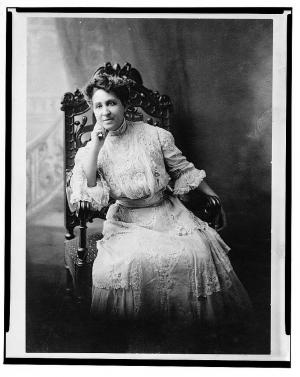Defiance and Dignity, Mary Church Terrell

In this lesson students will review a timeline of the life and legacy of Mary Church Terrell. Students will complete a close reading of a “The Progress of Colored Women.” Following this close reading, students will complete an exit ticket which asks them to apply an intersectional lens of gender and race to an issue they care about as well as apply the words, wisdom, and legacy of Mary Church Terrell.
Guiding Question:
How did Mary Church Terrell embody the concept of intersectionality in her activism and advocacy for civil rights and gender equality?"
20 minutes recommended
Students will learn about the life, contributions, and impact of Mary Church Terrell, a prominent African-American civil rights activist, suffragist, and educator. They will explore her achievements in the context of the struggle for civil rights and gender equality in the United States.
Students should have a basic understanding of the Civil Rights Movement, women's suffrage movement, social issues, an openness to discuss sensitive topics, and cultural awareness. Students should also be familiar with the concept of intersectionality.
Teacher will distribute the timeline of the life and legacy of Mary Church Terrell. Students will be asked to identify three key points of her life that you are think are the most important or consequential. Students will share out in small groups.
Students will complete the close reading of “The Progress of Colored Women” by Mary Church Terrell answering the assigned questions on the handout. In pairs, students will share out their response to the last question about a line that resonated with them.
Students will complete the assigned Assessment (see Assessment/Homework).
Based on what you have learned today about Mary Church Terrell and intersectionality, pick an issue that you care about and analyze it from the lens of race and gender. How does it look if you only examine it from race? How does it only look if you examine it from gender?
How can we use lessons from the words, life, and legacy of Mary Church Terrell to combat the issue you examined? In what ways are there historical thread lines?
-
Mary Church Terrell: Co-Founder of the NAACP, Video (PBS): https://ny.pbslearningmedia.org/resource/ull20-mary-church-terrell-video/unladylike2020/
-
National Portrait Gallery, Mary Church Terrell: https://npg.si.edu/object/npg_NPG.96.92
-
Biography: Mary Church Terrell: https://socialwelfare.library.vcu.edu/eras/terrell-mary-church/
CCSS.ELA-LITERACY.RI.11-12.2 Determine two or more central ideas of a text and analyze their development over the course of the text, including how they interact and build on one another to provide a complex analysis; provide an objective summary of the text.
CCSS.ELA-LITERACY.RI.11-12.6 Determine an author’s point of view or purpose in a text in which the rhetoric is particularly effective, analyzing how style and content contribute to the power, persuasiveness, or beauty of the text.
CCSS.ELA-LITERACY.RH.11-12.4 Determine the meaning of words and phrases as they are used in a text, including analyzing how an author uses and refines the meaning of a key term over the course of a text (e.g., how Madison defines faction in Federalist No. 10).
D2.His.4.9-12. Analyze complex and interacting factors that influenced the perspectives of people during different historical eras.
D2.His.3.9-12. Use questions generated about individuals and groups to assess how the significance of their actions changes over time and is shaped by the historical context.
D2.His.1.9-12. Evaluate how historical events and developments were shaped by unique circumstances of time and place as well as broader historical contexts.
